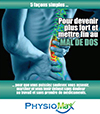Physiotherapy for Exercise in Bathurst
After you have established a regular exercise habit and have been at it for two or three weeks, your body will be getting used to the exercise and you will have started to acquire a level of fitness. Congratulate yourself for getting into a routine! Now in order to further build on this fitness, the body will need you to add intensity or change to your routine to challenge your body systems to a higher level of performance and fitness. Ideally, when you are doing your rhythmic, repetitive exercise (aerobic workout), which could be brisk walking, stair climbing, cycling, dancing, swimming, skating, or cross country skiing, the goal is to exercise at such an intensity that you raise your heart rate up to a training range of 60-80% of your maximum heart rate. Your maximum heart rate is about 220 subtract your age. If you calculate 60% and 80% of that number, you will know your training range. That being said, it is much more difficult to accurately take your heart rate while you are exercising, unless you have a heart rate monitor. Without getting wrapped up in the technicalities of heart rate monitoring, a general guide for exercise intensity is to try to stay at an intensity that allows you to still be able to converse, not so hard that you are gasping, not so easy that you can whistle.
It is recommended that the duration of the aerobic session be 20-60 minutes, though research has shown that there are benefits if the exercise is broken into more than one 10 minute session each day. The change in intensity can be achieved by changing speed, the terrain, or route, by adding in a hill, and by increasing the distance or time. If you are planning to increase the intensity of your exercise beyond regular walking, it is advisable to consult your doctor for any health precautions that you specifically might have. It is best to chose activities that suit your body, and honor any health issues that you might have. Most importantly, chose activities that you enjoy doing! You may find it more enjoyable to exercise in company, so go with a friend or join a group! You may find it motivating to keep track of your activity so jot down your exercise on a calendar, note the time spent, the distance, and how you felt. You will then be able to look back and note your progress. Some people are motivated by setting goals such as a distance achieved, or with preparation for community walks or fundraising rides.
Along the way, you may experience some of these common injuries:
Shin splints: May occur if your shoes do not provide adequate shock absorption or you are walking on hard surfaces, downhill, or increasing your distance too quickly.
Trochanteric Bursitis: I f you are walking on a road, with a camber, where your left leg is always lower than your right., may predispose you to an uneven pelvis, and added friction to the bursae.
Iliotibial Band Pain: Similarly, may occur from walking repeatedly on cambered road where left leg is lower than the right. I Stretches for your ITB should be done especially if you are exercising on a cambered road.
Other Relevant Information






